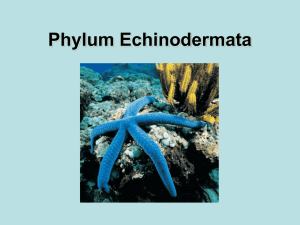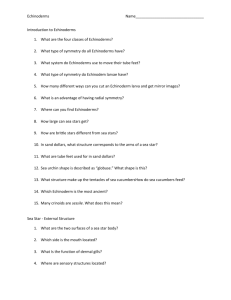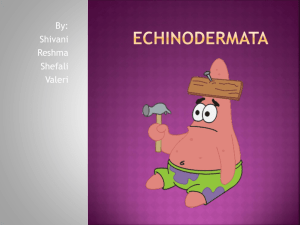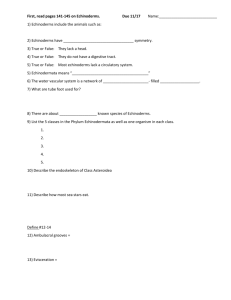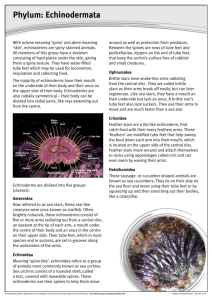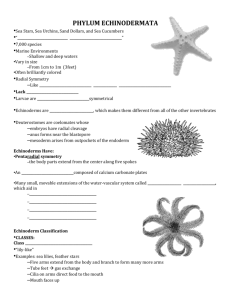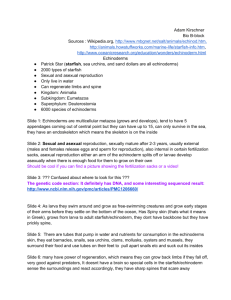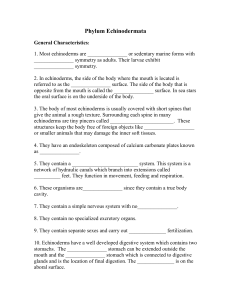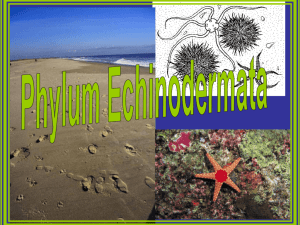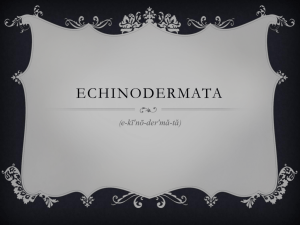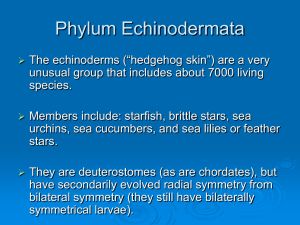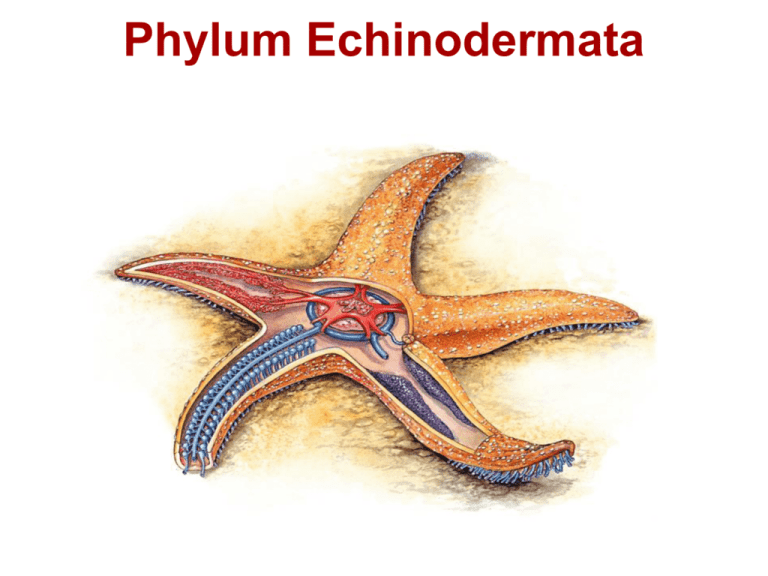
Phylum Echinodermata
Some Representatives of
Echinodermata
copyright cmassengale
Echinoderms characteristic summary:
spiny skin (Echinoderm means
“spiny skin”)
an internal skeleton
a water-vascular system
suction-cup structures called tube
feet
Copyright Pearson Prentice Hall
Evolution & Classification
Echinoderms are from the Cambrian period &
date back to over 500 million years ago
Scientists believe that they evolved from
bilaterally symmetrical ancestor.
Modern echinoderm larva is similar to
proposed ancestral species.
Echinoderms are deuterostomes, animals in
which the blastopore develops into an anus
This fact leads them to be most closely
related to the phylum Chordata (also
deuterostomes)
Ecology of Echinoderms
A sudden rise or fall in the number of
echinoderms can cause major changes to
populations of other marine organisms.
Sea urchins help control the distribution of
algae and other forms of marine life.
Sea stars are important predators that help
control the numbers of other organisms.
The crown-of-thorns sea star has destroyed
extensive areas of coral in the Great Barrier
Reef of Australia.
Echinoderm Body Plan:
Coelomates
No cephalization (no head or brain)
Most have five radii which is known as
pentaradial symmetry
Two rows of tube feet run along the
underside of each arm.
Endoskeleton that is made up of calcium
plates called ossicles, and they may include
protruding spines
Echinoderm Body Plan:
The side of the body where the mouth is
located is referred to as the oral surface.
The opposite side is called the aboral
surface.
The body of a sea star is usually covered
with short spines.
Surrounding each spine in many sea stars
are numerous tiny pincers called
pedicellariae.
http://www.potosisd.k12.wi.us/staff/hutchcroft/Biology%20Notes/Power%20PresentationsBiology/START%20Power%20Presentations.html
Form and Function in
Echinoderms
Do not have circulatory, respiratory, or
excretory systems
Echinoderms have a system of internal
tubes called a water vascular system.
The water vascular system carries
out many essential body functions,
including respiration, circulation,
and movement.
The Water Vascular System
The most distinctive system of echinoderms is the
water-vascular system, shown here in a sea star.
The Water Vascular System
The water vascular system opens to the outside
through a sievelike structure called a madreporite.
madreporite
The Water Vascular System
A tube foot is attached to
each radial canal.
•The upper end of each
tube foot is called an
ampulla.
•These contract forcing
water into the tube foot
making it extend.
The Water Vascular System
Tube feet act together to create enormous force
allowing echinoderms to “walk,” and pull open shelled
prey.
Video
Feeding & Digestion
Echinoderms have several methods of
feeding.
Sea urchins scrape algae from rocks.
Sea lilies use tube feet to capture
floating plankton.
Sea cucumbers move across the
ocean floor, taking in sand and
detritus using mouth tentacles.
Feeding & Digestion
Most sea stars are carnivorous and they
tend to each mollusks
The sea star can turn its cardiac stomach
inside out through its mouth when it feeds.
The cardiac stomach transfers food to
the pyloric stomach, which connects to a
pair of digestive glands in each arm.
Respiration & Circulation
Thin-walled tissue of the tube feet
provides the main surface for respiration.
In some species, small outgrowths
called skin gills also function in gas
exchange.
Circulation of materials and wastes
takes place using the water vascular
system.
Excretion
Digestive wastes are released as feces
through the anus.
Nitrogen-containing cellular wastes are
excreted primarily in the form of
ammonia.
This waste is passed into
surrounding water through tube feet
and skin gills.
Response
Have a nerve ring that surrounds the
mouth, and radial nerves that connect the
ring with the body sections.
Have scattered sensory cells that detect
light, gravity, and chemicals released by
potential prey.
A nerve ring surrounds the mouth with
a radial nerve in each arm
Eye spots respond to light
Tentacles respond to touch
Movement
Most echinoderms move using tube
feet.
Sand dollars and sea urchins have
movable spines attached to the
endoskeleton.
Sea stars and brittle stars use their
arms for locomotion.
Sea cucumbers crawl by using both
tube feet and the muscles of their body
wall.
Reproduction & Development
Most echinoderms have separate sexes.
Each arm of the sea star contains a pair
of ovaries or testes.
Fertilization occurs externally in water.
Each fertilized egg develops into a
bilaterally symmetrical, free-swimming
larva called a bipinnaria.
Echinoderms also have remarkable
powers of regeneration (asexual)
The 5 Echinoderm Classes
Class Crinoidea (means “lily-like”)
Members of the class Crinoidea, called
crinoids, include the sea lilies and feather
stars.
In both types of crinoids, five arms extend
from the body and branch to form many
more arms—up to 200 in some feather star
species.
Crinoidea are sessile
They have long stalks
that attach to rocks or to
the ocean floor
Sticky tube feet that
are at the end of each
arm catch food and
serve as a respiratory
surface.
Crinoidea
(“lily-like”)
Class Ophiuroidea (means “snake-tail”)
Ophiuroidea is the largest Echinoderm
class
Basket stars and brittle stars
Members of this class are distinguished
by their long, narrow arms, which allow
them to move more quickly than other
echinoderms.
Ophiuroidea
(“snake-tail”)
Primarily live under stones & in
crevices and holes of coral reefs
Have thin brittle arms that break off &
regenerate quickly
Feed by raking food off the ocean floor
with their arms and bottom of tube feet
Class Echinoidea (means “spinelike”)
Echinoidea consists of about 900 species
of sea urchins and sand dollars
The internal organs are enclosed within a
fused, rigid endoskeleton called a test
Echinoidea
(“spinelike”)
Sea Urchins
Live on rocks or coral reefs
A complex jaw-like mechanism called an
Aristotle’s lantern is used to grind their food
Scrape food/algae off rocks and coral
Sand Dollars
Live along seacoasts & sandy areas
Flat, round shaped bodies adapted for
shallow burrowing – use short spines to
move and dig
Filter feeders
Class Holothuroidea (means
“water polyp”)
Sea cucumbers belong to
the class Holothuroidea.
Armless soft bodies
Live on the sea bottom,
where they crawl or burrow
into soft sediment by using
their tube feet.
Holothuroidea (“water-polyps”)
Feed with tentacles
around the mouth which
sweep up sediment from
the water
Can protect
themselves by ejecting
internal organs – called
evisceration
Class Asteroidea (means “star-like”)
Sea stars, or starfish, belong to the class
Asteroidea, which means “starlike”
found all over coastal shores around the
world
Eat mollusks
http://www.potosisd.
k12.wi.us/staff/hutch
croft/Biology%20Not
es/Power%20Present
ationsBiology/START%20P
ower%20Presentatio
ns.html


